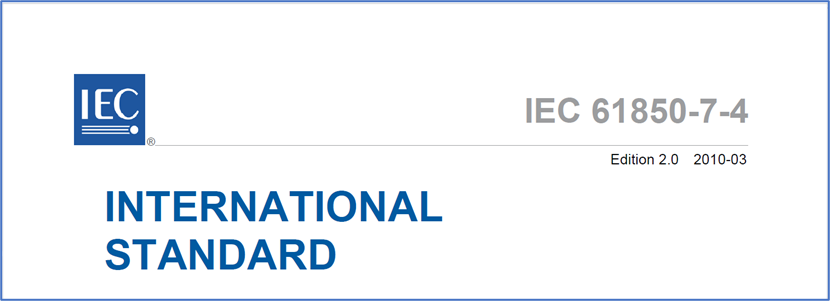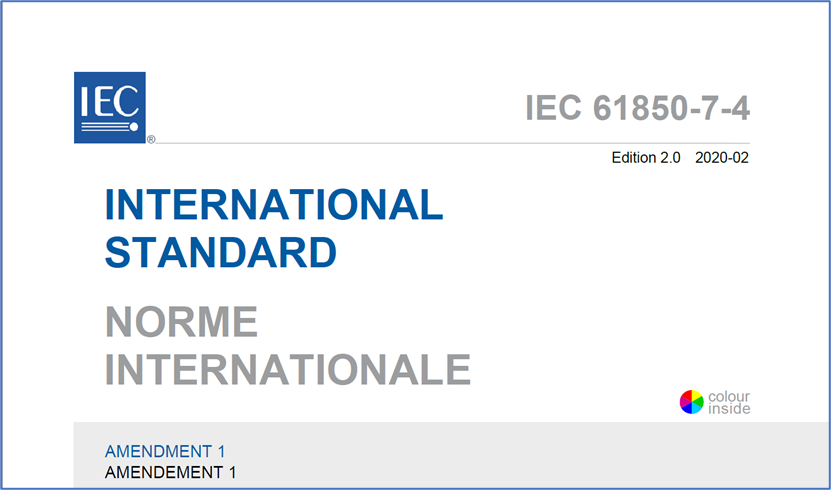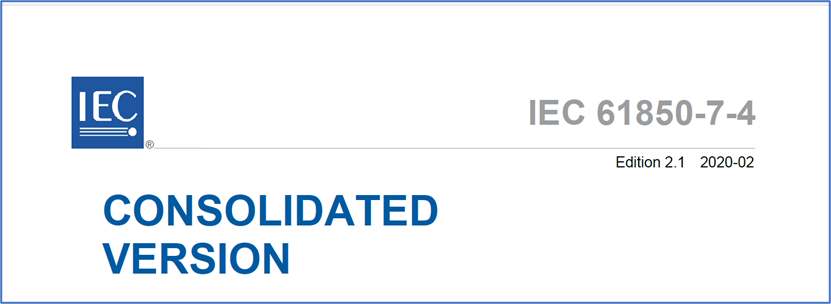Edition 2.1 CSV ... this document is NOT an International Standard
| Rod Hughes Consulting General Web Site | Applications Home | Innovations and Solutions Home | A bit about Rod Hughes |
|
|---|
Note - if the navigation pane on the left of this window is not visible, click the 2-pane icon on the top bar
As Users (developers, system integrators or asset owners) it may surprise you to learn that officially, certain IEC 61850 documents available from the IEC released in 2020 and which we generally call "Edition 2.1" are NOT documents that we can legitimately call "International Standard".
The purpose of this posting is to explain the way the different documents are referenced in order to help eliminate any potential confusion and misapplication of the term "International Standard" in what is referred to as "Edition 2.1"
Once you know what the documents are, it may help you reference them and apply them as well as understand the basis of the format of the Certificates of Conformance issued as a result of certification testing according to IEC 61850‑10.
Some may think this is "making a mountain out of a mole hill" and/or "it is obvious what is meant".
Fine.
I am not "in authority" in respect of either the IEC, IEC TC57 WG10 or the UCAIUG. However I have been in discussion with them over the last few weeks.
This "mountain" of explanation as a result of those discussions is indeed a substantial read, but because of the potential for mis-understanding, I think it needs to be spelt out in detail so that when we speak or write "in CORRECT short hand terminology", we can all know what is truly meant.
"Short" Summary
The following summary tries to define how to use various documents (using Part 7-4 as example) as the the current "state of the art" for IEC 61850‑6, 7‑1, 7‑2, 7‑3, 7‑4, 8‑1 and 9‑2.
THE officially voted International Standard is made up by manually/mentally combining two individual IEC documents both front covers marked as "INTERNATIONAL STANDARD" and Status = "Valid":
Edition 2 https://webstore.iec.ch/publication/6017 as modified by Amendment 1 https://webstore.iec.ch/publication/27066
An Ed2.1 CSV as found by IEC Webstore home page https://webstore.iec.ch/ search is NOT an officially voted International Standard ... officially it is only for user convenience!
The Home page search for IEC 61850‑7‑4 yields a single third document known as Ed2.1 CSV https://webstore.iec.ch/publication/66551.
Unfortunately it is now also (misleadingly) marked as "INTERNATIONAL STANDARD" and Status = "Valid".
As such, Certificates of Conformance (CoC) cannot state conformance related to Ed2.1 CSV, even though that is effectively what has been tested.
They can state conformance in respect of "Edition 2 Amendment 1", implying tested to the officially voted Amendment 1 and the unchanged clauses of the officially voted Edition 2.
It would be wrong to say "THE International Standard is Ed2+AMD1" because the "+" is a reference to the title of Ed2.1 CSV document.
I would even suggest that it is wrong or at least misleading to say "The International Standard is Ed2 and AMD1" as compliance to the clauses represented by Ed2.1 CSV by definition excludes compliance to the original Ed2.
It is however irrefutably correct to say "THE International Standard is Ed2 as modified by AMD1"
In the respect that you want to easily read/reference the set of clauses that reflect the "state of the art" IEC 61850 requirements, then Ed2.1 CSV will certainly meet your needs, arguably more so than the individual Ed2 and AMD1 documents.
But note: if you ONLY have Ed2.1 CSV (CHF900) , or even if you have Ed2.1CSV and the AMD1 (CHF900 + CHF350), you cannot "derive" what the original Ed2 states - you would have to also buy Ed2 in its original form for an extra CHF350 ... total investment cost CHF1250 or CHF1600.
I'll leave you to consider if the Ed2.1 CSV is really truly "convenient" for the user 🤔
I also think there are some options that could be considered that would go a LONG way to eliminating misunderstanding of our colloquial every day use of terminology.
But you cam make up your own mind on that.
Available Documents
The IEC define an International Standard as a document that has been specifically and officially voted on and accepted.
The IEC Webstore has two current officially voted documents that can truly be called an "International Standard" (using IEC 61850‑7‑4 as an example)
| Document #1 | Document #2 | |
|---|---|---|
| IEC Webstore page | https://webstore.iec.ch/publication/6017 | https://webstore.iec.ch/publication/27066 |
Publication type | International Standard | International Standard |
| Publication date | ||
| Edition | 2.0 | 2.0 |
| History page Status | Valid | Valid |
| Document title | IEC 61850‑7‑4:2010 | IEC 61850‑7‑4:2010/AMD1:2020 |
| Price | CHF350 | CHD350 |
| Colloquially called | Ed 2 | AMD1 |
However if you use the IEC Webstore Home page search https://webstore.iec.ch/home for "IEC 61850‑7‑4" you will be directed to a THIRD document which is neither of the above and is NOT the officially voted International Standard 👎🤔😒.
I have highlighted a few cells in the context of "confusion" as discussed below.
| Document #3 | |
|---|---|
| IEC Webstore page | https://webstore.iec.ch/publication/66551 |
Publication type | International Standard |
| Publication date | |
| Edition | 2.1 |
| History page Status | Valid |
| Document title | IEC 61850‑7‑4:2010+AMD1:2020 CSV Consolidated version |
| Price | CHF900 |
| Colloquially called | Ed 2.1 |
Edition 2.1 does not fix edition 2.0,.
What “fixes” edition 2.0 is the Amendment which you would "manually apply" to Ed2.
Edition 2.0 is still valid, it has not been replaced nor withdrawn, it may still be purchased through the Webstore alone, or together with its amendment, ... although for ease of reading (and you can afford it) you should consider buying the consolidated Edition 2.1 CSV.
The Confusion
Before anyone has a go at me trying to suggest I am misrepresenting or not understanding or just being wrong ... I have sought various clarifications from both the IEC directly and a few members of the IEC TC57 WG10 and the UCAIUG Testing Committee. What I reference here is simply my understanding of all that correspondence.
You may reference various "source" information here:
- https://webstore.iec.ch/home
- https://tinyurl.com/49yba6en
- https://webstore.iec.ch/webstore/webstore.nsf/xpFAQ.xsp?OpenXPage&id=ADMN-7NALG8
- https://www.iec.ch/members_experts/refdocs/iec/isoiecdir-1%7Bed12.0%7Den.pdf
- http://www.ucaiug.org/Press%20Releases/UCAIug%20Announcement%20of%20ED2%20and%20ED2-1%20Conformance%20Testing%20Final.pdf
So please shake your head a bit to get rid of any pre-conceptions and imagine you are "Jan from ACME Co." who has never heard of IEC 61850 before and certainly have not bought a copy, and certainly has not seen any of the IEC Rules, Directives etc ..
Therefore when Jan searches for and downloads a document, it is reasonable for Jan to have total belief that what has been quickly downloaded is "THE STANDARD".
As you can see above, the IEC has THREE documents all of which have the same Publication type and front cover banner "INTERNATIONAL STANDARD"
.. well actually the Ed2.1 document was originally published with the front cover banner stating "CONSOLIDATED VERSION", but it has now been changed to state "INTERNATIONAL STANDARD", so you could say there are FOUR documents that have been published by the IEC at various times .. a portion of their front covers shown below
| Ed2 | |
|---|---|
| AMD1 | |
| ED2.1 CSV | Original published front cover Revised published front cover |
So Jan from ACME Co. could well ask ... which of these three documents with front covers marked "INTERNATIONAL STANDARD", and all three being Status = "Valid", is the official International Standard?
The absolutely technically correct answer is ... the current set of clauses representing the "state of the art" of the Standard is not a single document!
It is two documents that must be read in conjunction with each other.
The current state of the art of the technology is "Ed2 document as modified by AMD1 document"
Reason: the only official documents are the original officially voted Ed2 (2010) and the subsequent officially voted AMD1 (2020) document
Under IEC Rules and Guidelines, Ed2 document REMAINS the official base edition of the Standard and has Status = "Valid",
... and the AMD1 document which also has Status = "Valid" and is a list of changes that you would have to read in conjunction with Ed2 document .
The IEC realise that the "mental merging" of Ed2 and AMD1 documents is quite difficult, especially with so many changes, and in fact whole new sections (e.g. Abstract Nodes).
Hence the IEC offer what they refer to as "Value Add documents" called "Consolidated Standard Versions" (CSV), but they are really "just for convenience".
https://webstore.iec.ch/webstore/webstore.nsf/xpFAQ.xsp?OpenXPage&id=ADMN-7NALG8
The FOREWORD of IEC 61850‑7‑4:2010+AMD1:2020 CSV, a.k.a Ed2.1 CSV, includes a large print note:
The IEC have stated in email exchanges that:
"Consolidated versions are derived from official publications, without modification of the original consensus-based technical content. The IEC Central Office guarantees the accuracy of their technical content”
It is possible (and is being worked on) to have an AMD2 which updates or adds to an existing AMD1 document, i.e. second amendment merged into the previous Ed2.1 CSV would be Ed2.2 CSV.
However the rules prevent an AMD3 .. that must become a whole new base Edition, which of course could possibly have its own future Ed 3 AMD1 and possibly Ed 3 AMD2.
Note that despite that FAQ page comments, the Ed2.1 CSV document provided by the IEC is NOT a "red line" version .. I suspect decided due to the sheer amount of Amendments ... the AMD1 document is itself 882 pages with statements like
"Replace existing Table 2 by the following new Table 3",
"Add the following new Subclause 5.4"
and whole new sections such as
"6.2 Abstract logical nodes (AbstractLNs)" which itself constitutes 60 (yes sixty) important pages up to clause 6.2.18.4 explaining how the subsequent individual Logical Node Data Object tables are presented!
Ed2.1 CSV as a stand alone document has NEVER been voted on, so it is not accurate to say it is THE current International Standard.
However "colloquially", the single document "Ed2.1 CSV" does represent the current "state of the art" of the effective Standard to which we would generally want devices to conform to, unless for some "legacy application" reason.
It would also be considered as INCORRECT or at least MISLEADING to say that
"the latest International Standard is Ed2+AMD1"
That is because the title of Ed2.1 CSV uses the "+" sign in its title
"IEC 61850‑7‑4:2010+AMD1:2020 CSV" .. and specifically that is not recognised as an officially voted document, so it cannot be "a Standard"
The full correct statement would be something like this
"THE latest International Standard is Ed2 document as modified by AMD1 document"
Some may use a shorthand phrase "the latest International Standard is/are Ed2 and AMD1" ... but this could potentially be misinterpreted as compliance to "Ed2 as modified by AMD1" does NOT imply .. and by definition is not compliance to unmodified Ed2.
A device may have
- a CoC for one firmware version or configuration selection compliance to original Edition 2,
and another subsequent CoC for a different firmware version or configuration selection which behaves differently and has been tested according to the clauses represented by Ed2.1CSV
or - ONLY a CoC relative to "Edition 2 Amendment 1" i.e. the clauses represented by Ed2.1 CSV
Conformance testing to original Ed2 only is allowed until January 2024. Thereafter it may be requested to the original Ed2 only, but only after successful testing to the clauses represented by Ed2.1 CSV.
Ed2.1 Conformance .. what does that (officially) mean ?
Technically it means NOTHING, or at least nothing officially, simply because Ed2.1 CSV document is NOT an officially voted International Standard document to which direct conformance is required/expected.
Hence under IEC considerations, no-one could officially issue an "true" IEC 61850‑10 Certificate of Conformance (CoC) to something that is not a Standard.
IEC 61850‑10 Conformance Testing to the latest "state of the art" collective Standard really means testing to Ed2 except where AMD1 tells you to test for something that has been updated, i.e. you would be really testing to the collated Ed2.1 CSV clauses.
I believe that the technically correct statement you should be using is "Conformance to Ed 2 as modified by AMD1". This is because the latest "state of the art" clauses are exactly that, and that is how the Part 10 Testing is done.
The Certificate of Conformance for a device conforming to "Ed 2 as also amended by AMD1" will state:
The server product has not been shown to be non-conforming to:
IEC 61850 Edition 2 Amendment 1 Parts 6, 7‑1, 7‑2, 7‑3, 7‑4, 8‑1 [and 9‑2 and IEC 61869 First Edition Part 9]
Communication networks and systems for power utility automation
That means effectively means/implies that the clauses that have been tested for are as shown collectively in the Ed2.1 CSV document, but you will note that there is no mention of anything as "Ed2.1"
Looking ahead: AMD2 of Ed2
Given the above, it seems reasonable to hypothesise what will happen when the next amendment document is issued .. yes, it is in preparation.
There will be FIVE documents available from the IEC:
- Ed2 document will remain valid and is THE base voted International Standard
- AMD1 will remain valid as an official voted amendment International Standard
- Ed2.1 CSV will remain valid, but not really classed as a voted international Standard - you would read this as "Ed2 as amended by AMD1"
- AMD2 will be valid as an official voted amendment International Standard
- Ed2.2 CSV will be valid, but not really classed as a voted international Standard - you would read this as "Ed2.1 CSV as amended by AMD2"
As yet I do not know what a future AMD2 CoC would state ... but it could be double confusion if they are not clear.
My view
My view is that this is a bit of a mess semantically, but as long as you know what it means (after all, that is what Part 7 is all about!!) it is OK.
- Three documents all concurrently showing Status = "Valid" and front cover marked as "INTERNATIONAL STANDARD"
- The IEC Webstore search takes you to a Ed2.1 CSV document which is NOT an officially voted International Standard document,
and which costs 128% of the two official documents if you don't have those already,
or if you already have original Ed2, you have to pay 257% of the original Ed 2 in order to get a new and easy readable document!
or you have paid a total CHF1600 for a complete set of documents which originally only cost CHF350 for the base Standard!!! - Your specifications requiring the latest "state of the art functionality" should really state "Conformance is required to Ed2 as modified by AMD1 of Ed2"
In the future that may need to be "Conformance is required to Ed2 as modified by AMD1 of Ed2 and AMD2 of Ed2"
Also my view (although not my decision) of an approach that could be taken is that
- The IEC should change their Ed2.1 CSV document front cover and revert to using the term "CONSOLIDATED VERSION", not "INTERNATIONAL STANDARD" .. because as a "stand alone" document directly referred to by their Home page search, it is not an "officially voted International Standard" .. such a different front cover would at least HINT that it is a different "pedigree" of document.
The IEC change status of Ed2.1 CSV to something OTHER THAN “Valid” … perhaps “Collation” or ”AMD1 update” or something that doesn't quite suggest it is the valid International Standard as such??
The UCAIUG change their CoC format to clearly state “not shown non-conforming to Ed2 as modified by AMD1” or some such.
An alternative approach (perhaps harder to achieve but which would then agree with colloquial use in the industry) is that
- IEC change their rules that somehow means that when an Amendment is voted and accepted, the Ed2.1 CSV is automatically accepted as THE current International Standard and Status marked as “Valid”
- The base edition document Status is not marked "Valid", but marked as “Original” or some such,
and the AMD1 Status marked as ”Modifications only” - The CoC format then just needs to be “not shown non-conforming to Ed2.1
- Protection Systems Engineering
- IEC 61850 Engineering
I provide a range of courses for company-specific in-house training and occasional public invitation courses. Contact me for details.
Contact Me
A phone call is nearly always welcome depending on the time of night wherever I am in the world.
Based in Adelaide UTC +9:30 hours e.g.
| April-September | Noon UK = 2030 Adelaide |
| October-March: | Noon UK = 2230 Adelaide |
Office + 61 8 7127 6357
Mobile + 61 419 845 253
Extra Notes:
Rod Hughes Consulting Pty Ltd accepts no direct nor consequential liability in any manner whatsoever to any party whosoever who may rely on or reference the information contained in these pages. Information contained in these pages is provided as general reference only without any specific relevance to any particular intended or actual reference to or use of this information. Any person or organisation making reference to or use of this information is at their sole responsibility under their own skill and judgement.
No Waiver, No Licence:
This page is protected by Copyright ©
Beyond referring to the web link of the material and whilst the information herein is accessible "via the web", Rod Hughes Consulting Pty Ltd grants no waiver of Copyright nor grants any licence to any extent to any party in relation to this information for use, copy, storing or redistribution of this material in any form in whole or in part without written consent of Rod Hughes Consulting Pty Ltd.




